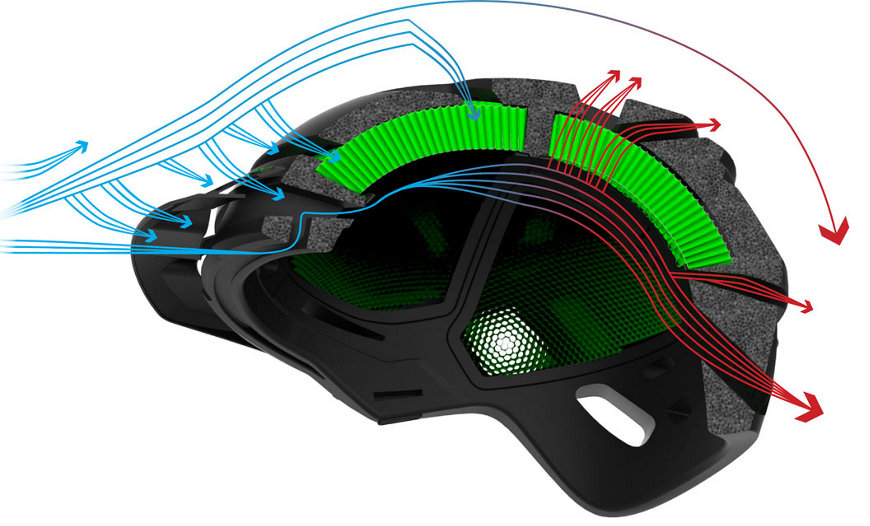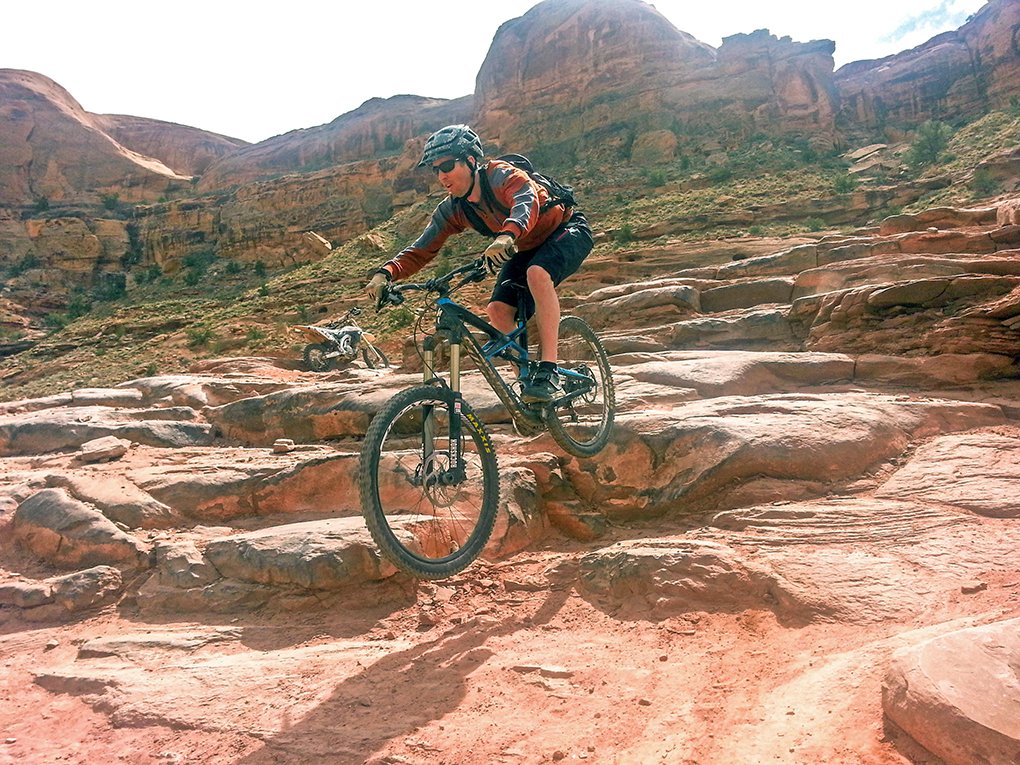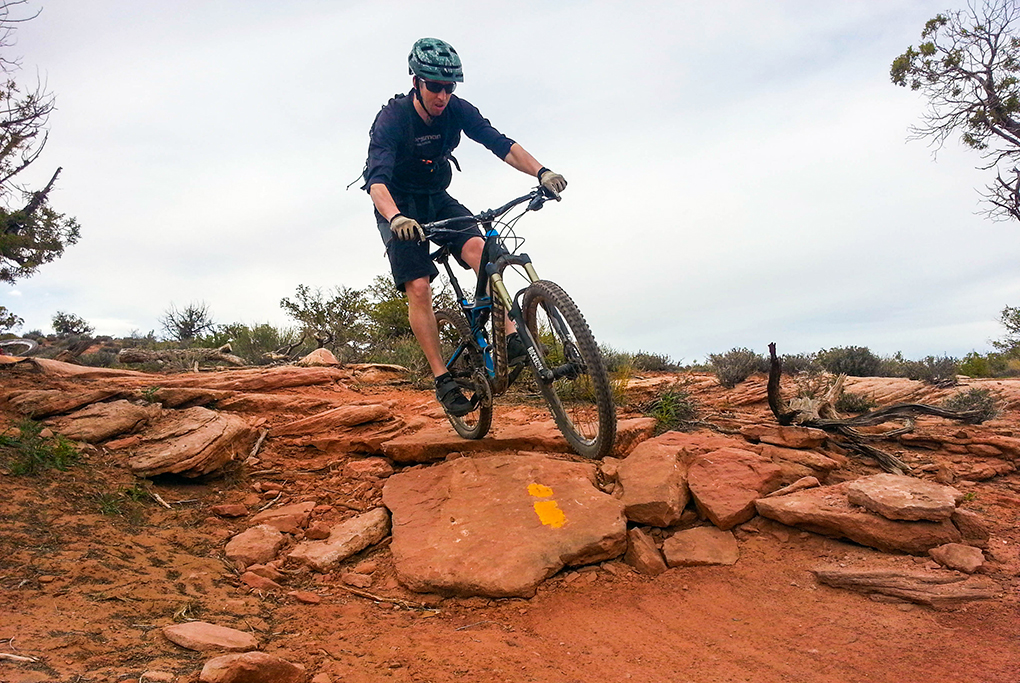The Forefront still uses some polystyrene foam in it’s construction, but in a much thinner layer than in traditional helmets—particularly on the top of the helmet. The remainder of the helmet’s thickness is Koroyd, which makes up roughly 2/3 of the shell thickness across the top. The entire lower periphery of the helmet is constructed with a full polystyrene and no Koroyd material.

Koroyd supposedly absorbs impacts better than polystyrene in that all of the little straws can crush in a more efficient, controlled manner on impact, providing a better dissipation of energy than regular EPS foam. I don’t have any independent way to test this assertion, but the Forefront passes CPSC standards, so it carries the same safety certifications as most other helmets on the market.
(The Forefront passes CPSC (Consumer Product Safety Commission) standards for bicycle helmets, a mandatory standard that every bicycle helmet sold in the U.S. needs to pass. Europe has similar mandatory standards, marked as EN-1078, which the Forefront also passes.)

Some Notes on Features
The Forefront has a couple minor but noteworthy features. First, it comes with a standard ¼-20 mount inset into the top of the helmet which lets you mount all kinds of things to it, the most obvious candidates being POV cameras and lights. While I generally resist the temptation to go teletubbying around with a GoPro strapped to my head, those inclined to record their radness will be pleased with the ease of mounting their camera(s).
The Forefront also comes with a stick-on “strap organizer” to help keep goggle straps situated on the back of the helmet. I do occasionally wear goggles with my half shell, and the strap organizer is a nice touch. And it’s removable, so if you don’t need it, you’re no worse off.
The visor on the Forefront has two positions, Up and Down. Popping it up yields a slightly improved upward field of vision, but I don’t really think this feature is all that useful unless you’re doing backflips (which I’m not). Mostly, I find that the visor often inadvertently gets bumped to the upper position, which looks a little goofy.
Similar to other helmets I’ve worn, the Forefront doesn’t cooperate with cramming sunglasses into the vents. Those vents that aren’t blocked by the Koroyd material aren’t oriented in a way that allows this.
Weight
At around 327 grams with the visor on, the Forefront is the lightest “all mountain” helmet to have graced my scale. For reference, my Giro Xar helmet and the Specialized Tactic II both weigh around 335 grams, and the POC Trabec weighs around 345 grams. A 20 gram difference is basically unnoticeable, but it’s at least worth noting that the Koroyd appears to live up to its hype as a lightweight material.
Venting
Most of my time in the Forefront has been in comfortable, cooler conditions, not the best conditions to test a helmet’s venting capabilities. However I did get a relatively short ride in the Forefront at Interbike last fall, where the mercury was pegged somewhere around 105 degrees F. In all of my testing, more recently and at Interbike, I’d say the Forefront vents at least as well as any other helmet that I’ve worn.

The Forefront doesn’t have more vents than every other helmet out there, but among half-shell helmets designed to offer as much protection as possible, I’d say the Forefront is a top contender for the coolest (in the temperature sense of the word, not in the Val-Kilmer-as-Iceman sense of the word) I’ve tested.
Aesthetics
As I’ve said in pretty much every review I’ve written, if you’re looking to me to determine whether something looks good, then every other person on the planet must have suddenly disappeared. I can barely put a shirt on the right way, much less pick out gear that makes me look hella fly, or whatever the kids are calling it these days.
However, I will say that I mostly agreed with the early internet critics who thought that the Forefront looked funny. But in person, I don’t mind the looks of the helmet at all. I’d even say it’s actually a pretty good looking helmet.
It’s also comes in all sorts of color combinations, ranging from low-key and anti-obnoxious to full on Enduro-tarded.
Bottom Line
At $220, the Forefront is quite spendy. There was a time not long ago when POC’s offerings were considered super expensive, but the Forefront is more expensive than all but POC’s top of the line Trabec Race MIPS.
Ultimately you’ll have to decide if the price is worth it. What I can say is that the Forefront is an awesome helmet, and any minor quibbles I have are pretty easily outweighed by the good things that this helmet has to offer. It ventilates very well, is lightweight, and brings a new, interesting construction material to the table. The Koroyd composition of the Forefront is a significant departure from the vast majority of other helmets on the market, and since this is still a new technology, it comes with a cost. Over time, I have no doubt that less expensive helmets will become available with Koroyd.
So if you want to be at the forefront of this particular technological curve, Smith has got you covered.
(And yes, I’m going to end this review with that horrible pun.)

Nice review. “Aesthetics” paragraph one — best ever, and an area in which I might compete with you!
One note is that I believe Smith touts the helmet being constructed in a way that allows for glasses to be kind of clipped onto the top, upside down, facing backwards. Works pretty well, but not very easy to achieve with one hand.
Yup – I believe you’re correct on the sunglasses, but that’s only for certain models of Smith glasses (which I don’t own). I tried attaching my generic gas station sunglasses and couldn’t find any way to keep them on the helmet.
I just picked up a white one, size medium, from backcountry. I also happen to own some Smith Pivlock glasses, which fit as advertised. They seem pretty secure when put into that little channel on the top of the helmet. I’m coming off a Fox Flux, and the Smith helmet fits my head very well (longer front to back than side to side). It only took a minute to get it dialed in, with all the straps adjusted into position. *FWIW, I find Giro helmets tend to be made for guys with very round skulls.
I’ll try to follow up with some comments on the airflow, but here in North Idaho, I do like the fact that the koryod will keep the bees out of my helmet!
Follow up on the airflow. As long as you are moving, its good. At slow speeds, like if you are doing a hike-a-bike, there isn’t enough air moving into the front to “push” the hot air up and out. Overall, I’m digging this helmet.